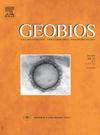A spatangoid echinoid assemblage from the Gutingkeng Formation (Early Pleistocene) of Taiwan and its paleoenvironmental and geological implications
IF 1.6
4区 地球科学
Q2 PALEONTOLOGY
引用次数: 0
Abstract
Heart urchins (Echinoidea: Spatangoida) collectively represent a highly diverse group of echinoids with abundant global fossil and extant records. Despite their wide distribution, the preservation challenges associated with their delicate and thin tests have led to limited comprehensive studies of this fossil group in Taiwan. Here, we report a new spatangoid echinoid assemblage from the Early Pleistocene part of the Gutingkeng Formation. Despite the inherent fragility and pronounced deformations in the studied specimens, the preserved key diagnostic characteristics (pore pairs in ambulacrum III and oral plating) indicate most of the fossil echinoids belong to genera Schizaster and Brissopsis. Moreover, based on detailed taphonomic and functional morphological examination, the paleoenvironment of the assemblage is interpreted as a low-energy, fine-grained soft substrate in a deeper shallow-water setting. Furthermore, this assemblage shares a high similarity with Assemblage 3 at the S’Archittu-Cajaragas section in the Miocene of Sardinia, supporting the notion that echinoids are excellent paleoenvironmental indicators, as similar echinoid faunas can be found across continents when environmental conditions are similar. On the other hand, the temporal and geographical distribution of Schizaster-rich echinoid assemblages in Taiwan may be correlated with the Cenozoic orogeny history of Taiwan.
台湾古亭坑组(早更新世)棘类生物及其古环境地质意义
胆胆是一种高度多样化的胆胆类动物,具有丰富的全球化石和现存记录。尽管它们分布广泛,但由于保存上的困难,以及对它们精细和单薄的测试,导致台湾对这一化石群的综合研究有限。本文报道了古亭坑组早更新世的一种新的蜘蛛形刺类组合。尽管所研究的标本具有固有的脆性和明显的变形,但保存下来的关键诊断特征(ambulacrum III和oral plating的孔对)表明,大多数棘足类化石属于裂裂属和布氏纲。此外,通过详细的地形学和功能形态学研究,认为该组合的古环境为低能、细粒的浅水软底环境。此外,该组合与撒丁岛中新世S’architu - cajaragas剖面的第3组具有高度的相似性,支持了棘虫类是优秀的古环境指标的观点,因为在环境条件相似的情况下,类似的棘虫动物群可以在各大洲发现。另一方面,台湾富裂殖子类刺毛虫组合的时间和地理分布可能与台湾新生代造山史有关。
本文章由计算机程序翻译,如有差异,请以英文原文为准。
求助全文
约1分钟内获得全文
求助全文
来源期刊

Geobios
地学-古生物学
CiteScore
3.30
自引率
6.20%
发文量
28
审稿时长
6-12 weeks
期刊介绍:
Geobios publishes bimonthly in English original peer-reviewed articles of international interest in any area of paleontology, paleobiology, paleoecology, paleobiogeography, (bio)stratigraphy and biogeochemistry. All taxonomic groups are treated, including microfossils, invertebrates, plants, vertebrates and ichnofossils.
Geobios welcomes descriptive papers based on original material (e.g. large Systematic Paleontology works), as well as more analytically and/or methodologically oriented papers, provided they offer strong and significant biochronological/biostratigraphical, paleobiogeographical, paleobiological and/or phylogenetic new insights and perspectices. A high priority level is given to synchronic and/or diachronic studies based on multi- or inter-disciplinary approaches mixing various fields of Earth and Life Sciences. Works based on extant data are also considered, provided they offer significant insights into geological-time studies.
 求助内容:
求助内容: 应助结果提醒方式:
应助结果提醒方式:


